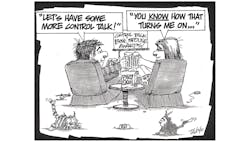This Control Talk column appeared in the July 2021 print edition of Control. To read more Control Talk columns click here or read the Control Talk blog here.
Greg: Last month in “Want to be a hero?,” we learned from a practical, insightful and entertaining example from Michel Ruel, ISA Fellow and co-chairman of the ISA 5.9 Technical Report on PID Algorithms and Performance, about how to sell an optimization project to your boss. Here we get an insightful inside view of the optimization project details from start to finish. The project is expected to save $20K per week by reducing downtime, and require an investment of 300 hours and $50K.
Most people don’t realize an optimization project is more than just implementing software to find and seek an optimum. What are the requirements and expected commitments for the project?
Michel: The integrity of 76 instruments needs to be reviewed and improved as necessary from the maintenance budget. Advanced regulatory control will be used to improve strategies and performance of 11 control loops. Twelve hours will be spent on databases and an historian and 75 hours on assessment of installation, calibration and configuration. Remediation to calibrate, repair, replace and configure will take about 140 hours. Optimization in terms of retuning and configuring special functions (e.g., setpoint filter) will take 33 hours. Actual advanced control by addition of feedforward and constraint control will only require 12 hours. Performance evaluation and documentation will take four and 24 hours, respectively. A team of 10 people working part time over a period of three weeks is expected.
Greg: What's the detailed breakdown of costs?
Michel: The material cost for replacement of one valve, upgrade of variable speed drive (VSD), and repair of a few instruments will be covered by the maintenance budget. The expected effort is 30 hours by a consultant, 40 hours for operator training, 140 hours for coordinated effort of maintenance technicians and engineers, 30 hours for programming, and 60 hours for other miscellaneous work.
Greg: What's the preliminary work?
Michel: Make sure scan and data historian rate is fast enough (e.g., 1 sec or less) and compression is turned off because we need real data for analysis. Review associated documents (e.g., DCS and/or PLC function, calibration sheets, specifications, process flow diagrams, process and instrument diagrams, standard operating procedures). Use all available information and data from our systems. Plan well, work less! In many plants, this part becomes an issue; old drawings and diagrams aren't updated, and we need to upload and download the last version of programs and configurations since documentation is obsolete.
Greg: What's done during assessment and remediation?
Michel: Visual inspection, review of configuration, analysis of historical data, analysis using specialized software and testing, recommendations, remedial actions and suggestions to improve maintenance. Calibration methods and installation practices are reviewed and improved, and equipment is repaired. Requirements for extra budget and new equipment, and process modification by future projects is noted.
Greg: How about improving loop performance?
Michel: Select criteria using a performance monitoring tool. Improve models and reduce interactions. Use best PID structure for application. In this case, we plan to improve grade changes. Historical data, especially setpoint changes, will be used to retune loops; no need for bump tests. Tune and automate setpoint changes as needed for startup, transitions and grade changes. Test loops making output changes for load response tests and setpoint changes for setpoint response tests. Review and optimize control strategies. Evaluate system performance (e.g., peak error, integrated absolute error, overshoot, rise time). Improve soft sensors.
Greg: What are the opportunities with advanced regulatory control (ARC)?
Michel: Use ARC to stabilize production, handle constraints, deal with interactions, protect equipment, and manage production rate and grade changes. Use feedforward control for measured disturbances and production rate changes and decoupling; again, using historical data, models will be identified. Use override control for constraint control. Use procedure automation for startup, transitions, grade changes and abnormal operation.
Greg: What about project completion?
Michel: This is the most important step. Document improvements in design documents and performance measurement with “before” and “after” numbers and dollars. Spread the good news. Present results. Congratulate the team. Congratulate your boss for funding the project. No need to be shy!
Greg: What are some examples of time requirements for larger projects?
Michel: For a large concentrator in the mining industry and an ore process plant—both in North America—235 and 314 hours in preliminary work, 2,269 and 4,624 hours in assessment, 4,300 and 8,100 hours in remediation, 345 and 1,105 hours in optimization, and 108 and 167 hours in advanced control were spent, respectively. You can see the actual hours for optimization and advanced control are much less, showing the importance of precursor efforts often neglected in the literature. Usually, such projects have ROI of weeks or months, not years.
Greg: What are the many multifaceted benefits of these projects?
Michel: There's improved productivity and efficiency, higher yield, fewer unplanned shutdowns, easier and more stable operation, lower energy costs, fewer emissions, lower consumption of raw materials, improved safety, longer equipment life, standardized management of control strategies, predictive and proactive maintenance, simplified troubleshooting, better quality, improved quality control, standardized procedures and follow-ups.
Greg: One thing I like to emphasize is that better process control provides better analysis of operation and problems by reducing variability in key process variables, allowing users and software to better track down harder to find sources of variability and spot abnormal operation. Changes in operation are identifiable in the manipulated variables. The ISA 5.9 Technical Report on PID Algorithms and Performance provides a perspective on the overall opportunities. There are many different benefits stated for improvements.
What's often not realized is they can be broadly categorized as improvements in either process capacity or efficiency, and that there's frequently a tradeoff. (For example, increased capacity may be associated with a decrease in efficiency.) For this and many other reasons related to limited management understanding of process control and accentuated emphasis on budget and schedules, there needs to be a much greater emphasis on bottom-line impact. To avoid a copy job on control system upgrades, there should be a dollar amount estimated for the benefits of taking advantage of new system capabilities for process control improvements.
An increase in onstream time can translate to greater capacity but may be at the cost of less efficiency due to equipment degradation (for example, delayed cleaning or defrosting of heat transfer surfaces, or delayed regeneration or replacement of catalyst). If there's a decline in a saleable product, it might be better to shut down and improve the equipment. An increase in production rate may come at the cost of lower efficiency due to pushing constraints (for example, equipment and process operating limits).
An increase in efficiency can be seen as a decrease in raw material or utility use, including recycle processing and waste treatment. An increase in yield can be taken as an increase in efficiency by reducing feed rate or as an increase in capacity by keeping the same feed rate.
More flexibility in the product mix often causes a loss in efficiency and capacity during the transitions. Less inventory of raw materials and products may cause more frequent changes in the production rate that can propagate as an upset throughout the production unit. Ratio control can help coordinate such changes by proactively maintaining the mass balance, as seen on the process flow diagram.
A greater batch yield (greater endpoint product concentration) may come at a cost of a longer batch cycle time resulting in a decrease in process capacity if the slope of the concentration profile is decreasing. A benefit calculation should be done based on a predicted batch end point divided by predicted cycle time. The rate of change and future value computation for procedure automation can be used to make intelligent decisions near the end of the batch. Bottlenecks in production units downstream of the batch equipment may prevent increases in batch production rate from translating to increases in plant capacity. Real time modeling systems can find and evaluate the impact of any bottlenecks in the production unit, enabling evaluation of process capacity improvements. This is usually done using historical data.
10. Tune your response to relationship disturbances to minimize peak error
9. Tune your response to spouse requests to minimize rise time
8. Use procedure automation to deal with transitions and abnormal situations
7. Use rate of change and future value prediction to reach relationship sequential objectives
6. Employ feedforward control to proactively reduce upsets without causing inverse response
5. Pair your reactions to spouse’s requirements to minimize interactions
4. Employ feedforward control to decouple remaining interactions
3. Use override control to honor spouse’s constraints
2. Find the best setpoints for your relationship
1. Learn to say “Yes Dear” automatically.







